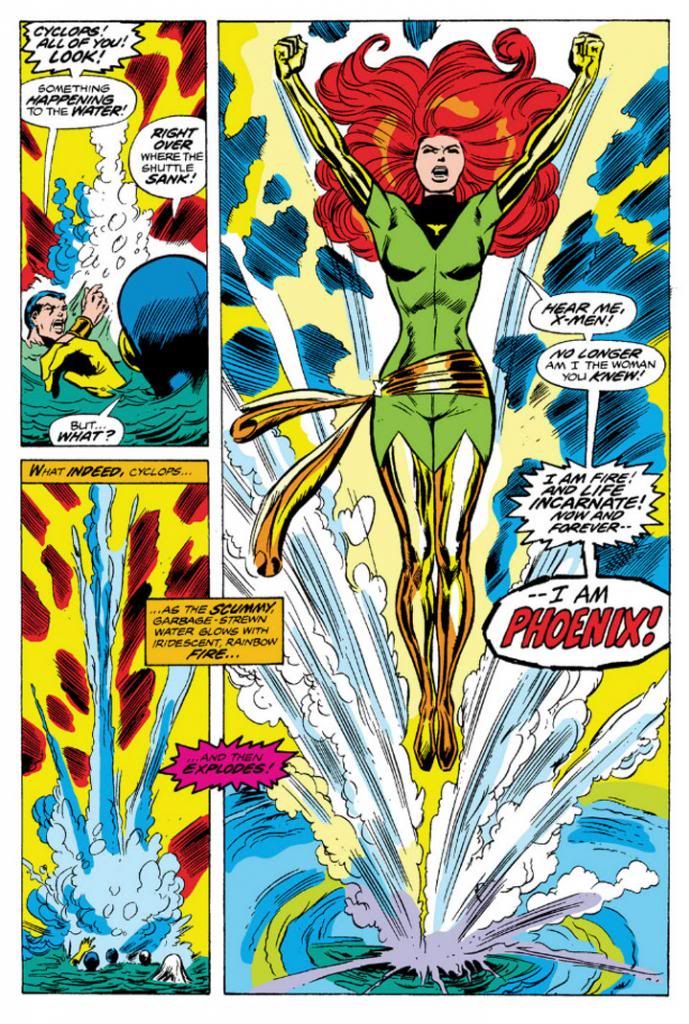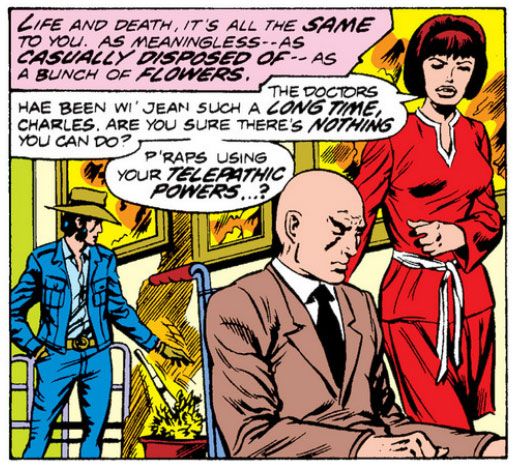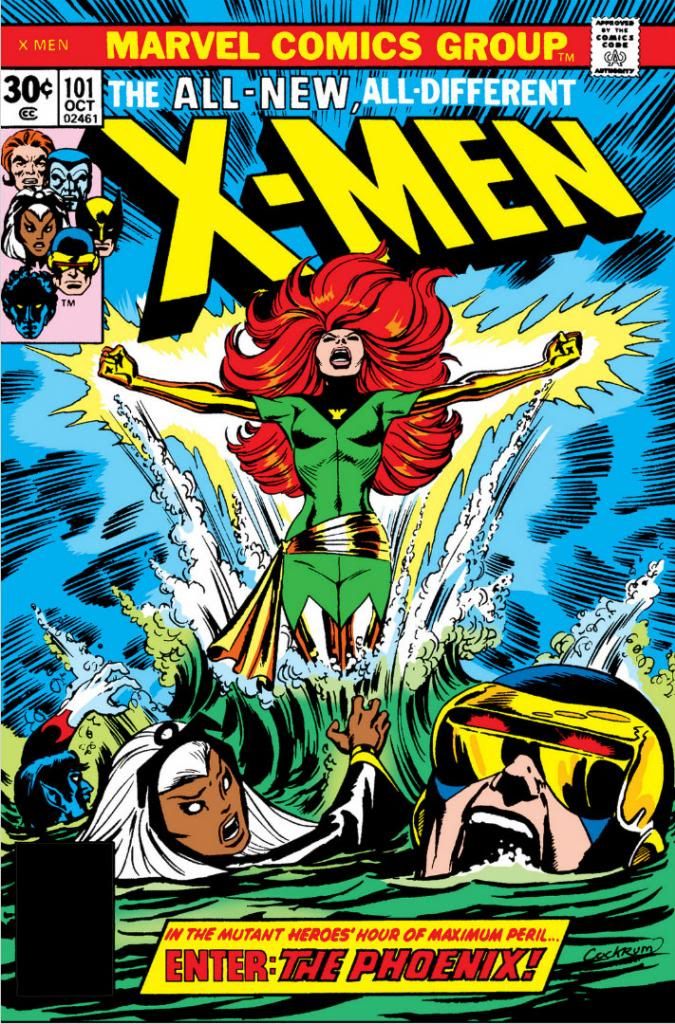Maybe even more so, because Lang stoops to murdering even a non-mutant USAF officer who calls him out on just how insane his schemes are and lions and hyenas only kill each other in their feuds. I can't think of a single lion who went so far as to bump off a leopard for telling him he's gone around the bend with the anti-hyena robot building enterprise. Lang captures the team and forces them to fight for their lives in space. It takes a couple of issues, but the good guys eventually prevail and, on the way home, fly through a solar storm. Only Jean Grey (or Marvel Girl as she was known then) can pilot them safely back.
The intense radiation, depicted psychedelically by Cockrum, triggers Jean's transformation into Phoenix, the all-powerful. But let's let Chris Claremont tell us what the new Jean Grey is all about as only he can:
 |
| X-Men #101, script by Chris Claremont, art by Dave Cockrum and Frank Chiaramonte |
Ahhhh! My, that's some good Claremont. "I am fire! And life incarnate!" has always struck me as a characteristically Chris Claremont phrasing. This may be because he was the guy who taught me the word "incarnate" in the first place. It's certainly not a word one slips into everyday conversation, at least not when I was a southern kid and living in my childhood home, where people were letter carriers, school secretaries and baseball players, not all-powerful mutants. And so this is the exact moment "incarnate" entered my vocabulary. To me, "incarnate" and "eldritch" are forever Claremont words, and when I read them in other comics, I always assume the writer has stolen them from Claremont's run on Uncanny X-Men. And by shouting this phrase, Phoenix lets us know she's here, she's for real, and readers look out!
This is the issue where Claremont found his X-voice. While he’d
already shown a sure hand at characterization, giving each rookie in his cast (and
even the previously-established veterans) distinct personalities and moods, the
first few issues trot out a tired Avengers villain, a random to the point of
being non sequitor demon attack and some story elements from the first X-Men
series. The new faces and the
ultra-detailed Cockrum art are the draws, not the stale plots. I know things were beginning to spark before
#101. Claremont had already started one
slow-building subplot about Professor X's strange dreams of distant interstellar conflict. This has a major pay-off later, and for the moment it meant Professor X gained what he'd largely lacked before-- a personality.
But the Phoenix story as it begins here is something else altogether. Claremont allowed it to flicker around the
edges of succeeding issues as he dropped clues and intriguing interludes before
the whole thing blazed up into major event unto itself, at once epic in scope
and intensely personal as well. Jean
Grey’s transformation into the most powerful of all the X-Men also serves
notice Claremont’s stories will be about the women as much as the men of the
group. Jean and Storm wouldn’t act as
cheerleaders or simple love interests, or worse, damsels in distress, with the
stories really being about the boys in the band. They wouldn’t be co-stars in someone else’s
adventures. They’d be stars, too. The women would get to drive the narrative as
much as anyone.
Cockrum emphasizes this moment in all its drama by having Phoenix dominate the page in a fury steam and lightning, one of those razzle-dazzle comic book light shows. It's also significant her rebirth takes place as she bursts from water-- both Claremont and Cockrum would have been fully aware of the symbolism. As she rises we see she's got this startling new costume and even seems to have more hair. The rest of the team end up crowded into those narrow panels on the left so Phoenix can own the entire space to the right. If you were holding this comic, this would be the outside part of the page, and this placing promises more Phoenix to come because she's the last thing you see before you turn to the next. Jean Grey and X-Men would never be the same.
But what's this? Back in those early, free-wheeling days before the X-Men became one of the major pillars holding up the Marvel cosmology, there was another little subplot happening, one Claremont didn't choose to develop into a major storyline. Back then, Wolverine wasn't a huge fan favorite and star of every single comic Marvel puts out each month plus his own movie series. In the first year or so of X-Men, he was just a short asshole mainly known for having fought the Hulk, but Claremont wasn't about to leave him as simple or one-note as all that. So the team rebel, the loner who doesn't need anyone (needed by no one in return, it seems) turns out to have a bit of a sweet side. Seems Wolverine has a cute little crushy-crush on none other than Jean "Phoenix" Grey herself.
 |
| X-Men #101, script by Claremont, art by Cockrum and Chiaramonte |
Aww! Like a lovestruck high school boy, he's not sure how to go about wooing her, but in his insecurity he plays the arrogant fool in his mind. Little bit of the caveman, I suppose. Claremont's narration is pretty harsh on the poor guy, though, don't you think? I mean, yeah, Wolverine thinks some dickish thoughts while awkwardly trying a tender gesture, but does he deserve the caption box hectoring he gets here?
 |
| X-Men #101, script by Claremont, art by Cockrum and Chiaramonte |
Probably.
In the last panel Claremont really lets the guy have both barrels, even though everyone involved knows there's a heart inside Wolverine's gruff, hairy, somewhat psychotic exterior. Actually, I've always thought of the intrusive, judgmental narrator as representing Wolverine's self-recriminations. That he didn't really like himself. It would be a while before they humanized him... and then overexposed him... but isn't it fun to see Wolverine getting a case of the goofies over Jean?


2 comments:
Spot on! Great review! I think I'm overdue for my biannual retreading of this run of X-books!
Thank you, thank you! Do you have the Archives or the Essentials? I'm reading these again because they're popping up on Comixology. I wonder what things might have looked like if Dave Cockrum had continued with the series, but that guy who replaced him was pretty good, too.
Post a Comment